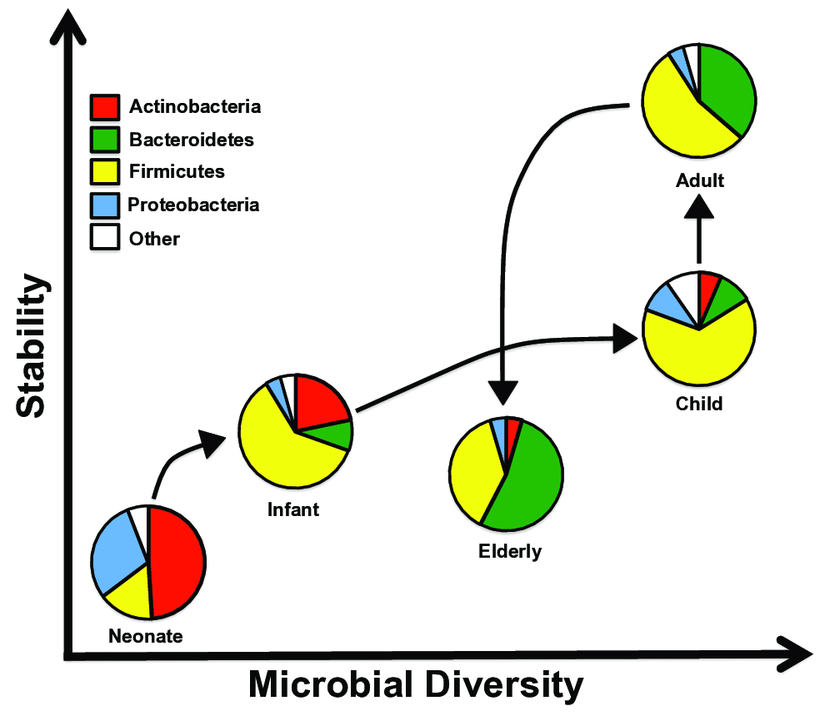6 Quiz
We hope that you have enjoyed studying about the fascinating subject of the gut microbiome! Below are a series of questions for you to assess your understanding and knowledge gained while studying this OpenLearn course.
Question 1 Microbiomes
Select from the drop-down lists to complete the following paragraph.
Question 2 Bacterial profiles
a.
Firmicutes and Bacteroidetes are the most abundant bacteria in the gut microbiome
b.
Bacteroidetes and Actinobacteria are the most abundant bacteria in the gut microbiome
c.
An individual’s unique community of bacterial groups is known as their enterotype
d.
Most individuals have a similar profile of bacteria in their gut microbiomes
The correct answers are a and c.
Question 3 Functions of the gut microbiome
a.
Protect against dysbiosis
b.
Destroy colorectal cancer cells
c.
Regulate appetite
d.
Reduce obesity
e.
Provide energy for the body and other microbiota
f.
Communicate with the brain
The correct answers are a, b, c, d, e and f.
Question 4 Dysbiosis
There are three main mechanisms which cause dysbiosis. Select from the drop-down lists to describe each mechanism.
Question 5 Health
Several health conditions have been linked to dysbiosis, and a change in diversity of the microorganisms of the gut microbiome. The ratio of Firmicutes to Bacteroidetes is thought to be particularly important in health. Drag the correct statement to the matching description.
Using the following two lists, match each numbered item with the correct letter.
-
Balanced ratio of Firmicutes to Bacteroidetes
-
Increase in Firmicutes compared to Bacteroidetes
-
Increase in Bacteroidetes relative to Firmicutes
Match each of the previous list items with an item from the following list:
a.Individual with Crohn’s disease
b.Obese individual
c.Healthy individual
- 1 = c,
- 2 = b,
- 3 = a
Question 6 Exercise
a.
Certain metabolites made by the gut microbiome have been linked to increased motivation to exercise
b.
Certain metabolites made by the gut microbiome have been linked to improved exercise performance
c.
The bacterial species Veillonella has been shown to increase the amount of lactate athletes can tolerate
d.
The benefits of exercise on microbiome health are pronounced in childhood
e.
Exercise is known to reduce the risk of colorectal cancer and Crohn’s disease
The correct answers are a, b, c, d and e.
Question 7 Obesity
Obesity is a complex, multifactorial condition linked to a wide range of genetic and non-genetic factors, including environmental, lifestyle, socioeconomic and psychological factors. Select from the drop-down lists to complete the following paragraph.
Question 8 Medications
a.
The lines on the graph suggest that antibiotic use does not seem to impact bacterial diversity
b.
Prior to antibiotic use, species richness fluctuates but remains below 45
c.
Three days after antibiotic use, species richness has decreased
d.
Six days after antibiotic use, species richness has returned to normal levels
The correct answer is c.
Question 9 Age
The graph below illustrates gut microdiversity over a typical human lifespan. The graph explores stability (i.e. whether the gut microbiome experiences lots of changes) and also gut diversity (i.e. the proportions of different types of bacteria in the gut microbiome). Look carefully at the graph and then answer the following questions.
From examining the graph, determine whether the following statements are true or false.
a.
True
b.
False
The correct answer is b.
a.
True
b.
False
The correct answer is a.
a.
True
b.
False
The correct answer is a.
Question 10 Diet
A balanced diet helps provide nutrients for the gut microbiome and the host. Select from the drop-down lists to describe the following food items.
Now consider the diets which typically incorporate these food items, and complete the sentences below.

